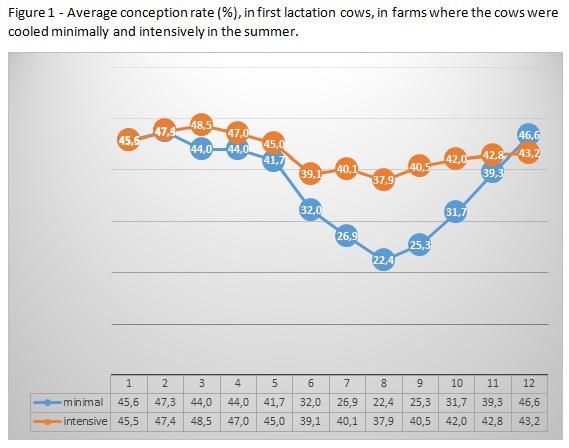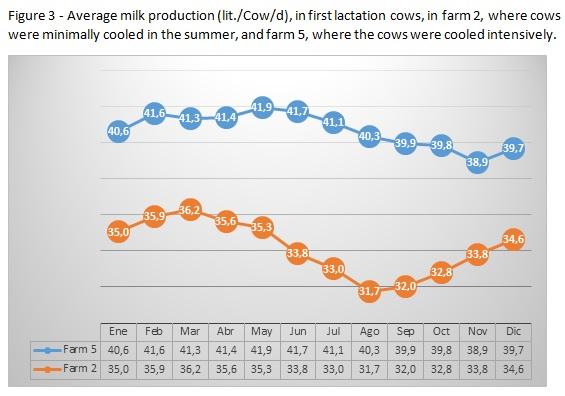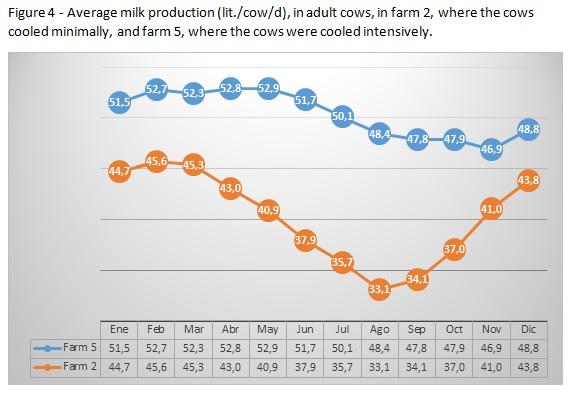How does intensive cooling in summer affect fertility of young and adult cows?
Published: December 14, 2023
By: Dr. Israel Flamenbaum – Cow Cooling Solutions Ltd, Israel
Global warming and the constant increase in cow yields aggravate the summer problem on dairy farms and increase the production losses caused to dairy producers. An important part of the losses caused is due to the negative effect of heat load on the fertility of cows that are inseminated in summer. To characterize this effect, we collected data from five large-scale, high-yield dairy farms (1,500 to 3,000 dairy cows per herd) located in the "Laguna" region of northern Mexico, characterized by a desert climate, with about 180 stressful days per year, where cows are exposed to heat stress conditions. Despite the desire to compare dairy farms with intensive cooling with those without, it turned out that "zero cooling" farms no longer exist in the region, and the minimum cooling, represented here in a couple of barns, is by wetting the cattle and forced ventilation, only in the waiting yard, before each milking session. Data from two minimally cooling farms was compared to three dairy farms where cows received intensive cooling, combining wetting and forced ventilation provided in 6 cooling treatments per day, lasting between 45 minutes and one hour each, applied before and between each milking session, one almost every 4 hours, throughout the day.
In this article, we present averages of the monthly conception rate per cow in the last five years (2019-2023) on farms with minimal and intensive cooling treatment. The following two figures show the averages of the monthly conception rate in the last five years, both for first lactation cows and for adult cows (two lactations and more).


As can be seen in Figures 1 and 2, intensive cooling in summer reduces by half or more the decrease in the conception rate of cows that are inseminated in this season. Unlike the reaction in milk, when it comes to conception, the decline in summer occurs similarly in young and mature cows, which is probably due to the greater sensitivity of fertility to heat, compared to milk production.
To examine the relationship between milk production and fertility, I chose two farms. Farm number 2, with minimal cooling, where the greatest decrease in milk yield was recorded in the summer and next to it is farm number 5, with intensive cooling, where the greatest milk yield and the smallest decrease in milk yield were recorded. The average milk production for the five years 2019 - 2023 is shown in Figure 3, for first lactation cows and in Figure 4, for adult cows.


In Figures 5 and 6 we can see the conception rates of young and adult cows in the same farms.


From what is shown in Figures 3 to 6 it can be clearly seen that achieving high milk production does not necessarily result in lower fertility. The magnitude of the production decline in the summer in intensively cooling farms was almost a third of that for cows in the minimally cooling farms, and this applied to both young and adult cows. A similar trend was also recorded in terms of conception rate. The decrease in conception rate in summer in the minimally cooling farms was more than double, compared to that in the intensively cooling farms. In addition to the higher level of summer production, cows with intensive cooling achieved higher conception rates that were more than double in young cows and three times higher in adult cows, as compared to cows in the farms with minimal cooling, where cow's milk yield in the summer was also lower.
In conclusion, it can be said that intensive cooling of cows makes it possible to significantly reduce the expected decrease in milk production in summer and, at the same time, reduces also the expected decrease in fertility.
It is clear now that intensive cooling of the cows in summer allows obtaining high milk production and at the same time, good fertility.
Related topics:
Related Questions
What are the causes of production losses on dairy farms?
Global warming and the constant increase in cow yields aggravate the summer problem on dairy farms and increase the production losses caused to dairy producers.
What is the impact of intensive cooling of cows on milk production?
Intensive cooling of cows makes it possible to significantly reduce the expected decrease in milk production in summer.
What is the effect of intensive cooling of cows on fertility?
Intensive cooling of cows reduces the expected decrease in fertility.
What are the benefits of intensive cooling of cows in summer?
Intensive cooling of the cows in summer allows obtaining high milk production and good fertility.
Authors:
Recommend
Comment
Share
27 de febrero de 2024
Hello Mr. Flaumenbaum
Could you send me your study about heatstress on cows in North Spain vs South Spain. I read it on a newsletter but can t find it anymore!
Your work and investigations are very fascinating!
Do you know the slick gene for short hairs, more sweating against heat stress?
I was asked whether the Israeli Holsteins have inherited this gene by former cows at the place?
Thanks for answering
Rudolf Haudenschild
Could you send me your study about heatstress on cows in North Spain vs South Spain. I read it on a newsletter but can t find it anymore!
Your work and investigations are very fascinating!
Do you know the slick gene for short hairs, more sweating against heat stress?
I was asked whether the Israeli Holsteins have inherited this gene by former cows at the place?
Thanks for answering
Rudolf Haudenschild
Recommend
Reply

Would you like to discuss another topic? Create a new post to engage with experts in the community.





.jpg&w=3840&q=75)